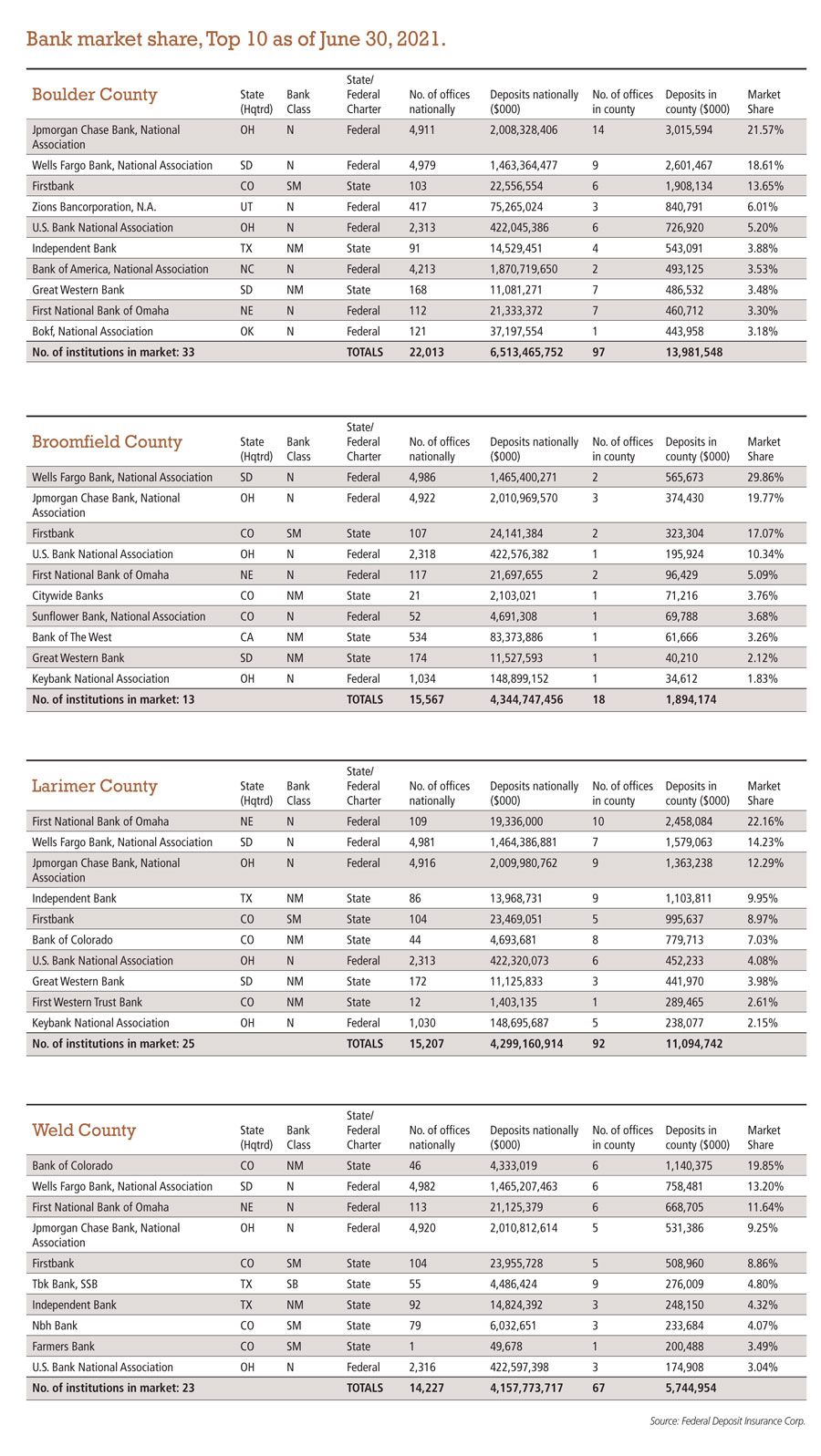Banks see best cash position in decades

Despite the pandemic and economic downturn of the past 19 months, banks are in a better cash position than they’ve been in 30 years — a position no bank thought was possible a year ago when they were shoring up their loan loss reserves in anticipation of a huge wave of pandemic-related loan defaults that didn’t materialize.
Many banks beat their pandemic forecasts. They provisioned a lot more money in the second half of 2020 to pay for expected losses but, in the end, those funds weren’t needed.
Now, those banks are shifting those funds around again, looking for good personal and business loans as deposits continue to grow.
SPONSORED CONTENT

“Most banks have done well,” said Shawn Osthoff, president of Bank of Colorado. “The past year has been a year of tremendous growth. At the same time we helped customers with round one and round two of the PPP (Paycheck Protection Program). We built a lot of new relationships through the PPP. Some of the larger banks were not able to deliver PPP loans. Community banks stepped up and delivered PPP loans to small businesses when they were not able to get it done through larger bank channels.”
Gerard Nalezny, chairman and CEO of Verus Bank of Commerce in Fort Collins, said that “typically you would not, in an effectively zero rate environment, see deposits so strong.” Usually, when interest rates go up, lending decreases and savings increases, “however, there is so much liquidity in the system in terms of consumers, investors and businesses, that’s what is making all those deposits. As those deposits get deployed, that will be a positive for banks as well,” he said. “Some of that deployment, those cash balances, deposits, will generate lending activity that will also be positive for banks in general.”
A rising interest rate environment will help normalize the situation, he added.
Verus Bank is one of the smaller banks in the area with one location in Fort Collins. It reported deposits of $214 million in June 2021, down 8.3% from deposits of $233.5 million in June 2020.
Wells Fargo Bank, the largest banking institution in Northern Colorado, reported deposits of $5.5 billion in Boulder, Broomfield, Larimer and Weld counties as of June 30, 2021, an increase of 6.3% compared to deposits of $5.18 billion in June 2020. The financial institution’s market share in the area was 16.83% in June 2021 compared to 17.76% during the same time frame in 2020.
FirstBank, which is the largest Colorado-based bank in Northern Colorado, reported deposits of $3.74 billion on June 30, 2021, a 17.3% increase from $3.19 billion in deposits in June 2020. The bank’s market share in Northern Colorado was 11.42% as of June 30, compared to 10.93% in June 2020. FirstBank declined to comment for this story.
Bank of Colorado’s deposits in Boulder, Broomfield, Larimer and Weld counties rose nearly 20% to $1.97 billion on June 30, 2021, from deposits of $1.64 billion on June 30, 2020. Its market share in Northern Colorado rose from 5.63% last year to 6.01% this year with 15 locations in the area.
The pandemic ended up affecting banks in a different way than the Great Recession.
“We didn’t know what would happen and were concerned about asset quality. Banks came through this with low asset quality problems,” said Osthoff.
Many small businesses were falling behind in their payments because they had to shut down and furlough their employees and the entire financial future of the country seemed to be teetering on the brink. But, with the help of the federal government’s Payment Protection Program, banks in Northern Colorado, at least, were able to keep many of their small business clients afloat long enough for them to devise new, more socially distanced business models.
Like many of their business clients, Colorado banks learned to adapt to the new business environment, figuring out how to serve their customers in a way that didn’t put them or their staff members at risk of catching COVID-19. Plans that had been in the works for years to encourage customers to do most of their banking online finally came to fruition.
Because many customers were quick to adopt online banking offerings, many banks in the state began to close or consolidate physical branches. Since June 2020, Wells Fargo has closed three of its branches in Northern Colorado and FirstBank closed two. First National Bank of Omaha closed one branch and U.S. Bank closed nine branches in Northern Colorado.
Colorado, and Northern Colorado in particular, is such an attractive market that even though larger banks are closing branches, other banks and credit unions are coming in, said Nalezny. “This is an opportunity.”
Bank of America and First Western Trust Bank each added one branch in Northern Colorado during the past year.
Osthoff said that banks have been consolidating their positions in the state for years, and he expects that trend to continue.
As banks put more of their resources toward online and telephone banking options and customers learn how to access those options, that will only lead to more consolidation, he said.
“It’s amazing how much online banking channels have grown compared to before the pandemic. It created efficiencies for banks and consumers too. Use of technology in general by customers made leaps and bounds in the past year or two,” Osthoff added.
Nalezny said that even though the state has opened up a bit from its 2020 pandemic restrictions, Verus Bank is seeing more customers using the drive through than coming into the lobby to conduct their business.

Despite the pandemic and economic downturn of the past 19 months, banks are in a better cash position than they’ve been in 30 years — a position no bank thought was possible a year ago when they were shoring up their loan loss reserves in anticipation of a huge wave of pandemic-related loan defaults that didn’t materialize.
Many banks beat their pandemic forecasts. They provisioned a lot more money in the second half of 2020 to pay for expected losses but, in the end, those funds weren’t needed.
Now, those banks are shifting those funds around again, looking for good personal and…
THIS ARTICLE IS FOR SUBSCRIBERS ONLY
Continue reading for less than $3 per week!
Get a month of award-winning local business news, trends and insights
Access award-winning content today!




